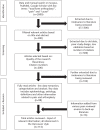Literature review of the causes of pain following total knee replacement surgery: prosthesis, inflammation and arthrofibrosis
- PMID: 33072405
- PMCID: PMC7528670
- DOI: 10.1302/2058-5241.5.200031
Literature review of the causes of pain following total knee replacement surgery: prosthesis, inflammation and arthrofibrosis
Abstract
Adverse knee pain occurs in 10-34% of all total knee replacements (TKR), and 20% of TKR patients experience more pain post-operatively than pre-operatively. Knee pain is amongst the top five reasons for knee replacement revision in the United Kingdom. The number of TKRs is predicted to continue increasing due to the ageing population.A narrative literature review was performed on the different causes of pain following TKR. A database search on Scopus, PubMed, and Google Scholar was conducted to look for articles related to TKR, pain, and cause. Articles were selected based on relevance, publication date, quality of research and validation. Relevant sections were added to the review.One hundred and fourteen articles were identified and potential causes of TKR pain included: arthrofibrosis, aseptic loosening, avascular necrosis, central sensitization, component malpositioning, infection, instability, nerve damage, overstuffing, patellar maltracking, polyethylene wear, psychological factors and unresurfaced patella.It is important to tailor our approach to address the individual causes of pain. Certain controllable risk factors can be managed pre-operatively to minimize post-operative pain. Risk factors help to predict adverse pain outcomes and identify specific causes.There are multiple causes of pain following TKR. Some factors will require further extensive studies, and as pain is a commonly attributed reason for TKR revision, its underlying aetiologies should be explored. Understanding these factors helps to develop effective methods for diagnosis, prevention and management of TKR pain, which help to improve patient outcomes. Cite this article: EFORT Open Rev 2020;5:534-543. DOI: 10.1302/2058-5241.5.200031.
Keywords: arthroplasty; knee; pain.
© 2020 The author(s).
Conflict of interest statement
ICMJE Conflict of interest statement: The author declares no conflict of interest relevant to this work.
Figures
Similar articles
-
Avoiding patellar complications in total knee replacement.Bone Joint J. 2014 Nov;96-B(11 Supple A):84-6. doi: 10.1302/0301-620X.96B11.34305. Bone Joint J. 2014. PMID: 25381415 Review.
-
[Causes and management of patellar instability after total knee replacement : Lateralization, subluxation and luxation].Orthopade. 2016 May;45(5):399-406. doi: 10.1007/s00132-016-3259-4. Orthopade. 2016. PMID: 27125236 Review. German.
-
Current failure mechanisms after knee arthroplasty have changed: polyethylene wear is less common in revision surgery.J Bone Joint Surg Am. 2015 May 6;97(9):715-20. doi: 10.2106/JBJS.M.01534. J Bone Joint Surg Am. 2015. PMID: 25948517
-
Why knee replacements fail in 2013: patient, surgeon, or implant?Bone Joint J. 2014 Nov;96-B(11 Supple A):101-4. doi: 10.1302/0301-620X.96B11.34350. Bone Joint J. 2014. PMID: 25381419 Review.
-
How Does Wear Rate Compare in Well-functioning Total Hip and Knee Replacements? A Postmortem Polyethylene Liner Study.Clin Orthop Relat Res. 2016 Aug;474(8):1867-75. doi: 10.1007/s11999-016-4749-8. Epub 2016 Feb 18. Clin Orthop Relat Res. 2016. PMID: 26891896 Free PMC article.
Cited by
-
Mismatch between trochlear coronal alignment of arthritic knees and currently available prosthesis: a morphological analysis of 4116 knees and 45 implant designs.Knee Surg Sports Traumatol Arthrosc. 2023 Aug;31(8):3116-3123. doi: 10.1007/s00167-022-07251-5. Epub 2022 Dec 2. Knee Surg Sports Traumatol Arthrosc. 2023. PMID: 36456826 Free PMC article.
-
Thyroid Diseases After Total Knee Replacement: A Multi-center, Propensity-score-matched Cohort Study.In Vivo. 2024 Sep-Oct;38(5):2446-2454. doi: 10.21873/invivo.13714. In Vivo. 2024. PMID: 39187324 Free PMC article.
-
The Optimal Variation Range of Posterior Condylar Offset Associated with Positive Clinical Outcomes of Primary Total Knee Arthroplasty: A Retrospective Analysis.Orthop Surg. 2024 Nov;16(11):2708-2713. doi: 10.1111/os.14183. Epub 2024 Aug 6. Orthop Surg. 2024. PMID: 39107882 Free PMC article.
-
Improvement in Central Sensitization Following Total Knee Arthroplasty Is Associated With Severe Preoperative Pain and Affects Postoperative Quality of Life: A Retrospective Study.Orthop Surg. 2025 Mar;17(3):876-887. doi: 10.1111/os.14342. Epub 2025 Jan 25. Orthop Surg. 2025. PMID: 39865510 Free PMC article.
-
Severe Postoperative Pain in Total Knee Arthroplasty Patients: Risk Factors, Insights and Implications for Pain Management via a Digital Health Approach.J Clin Med. 2023 Dec 15;12(24):7695. doi: 10.3390/jcm12247695. J Clin Med. 2023. PMID: 38137764 Free PMC article.
References
-
- Varacallo M, Luo T, Johanson N. Total knee arthroplasty (TKA) techniques. National Center for Biotechnology Information, 2020. https://www.ncbi.nlm.nih.gov/books/NBK499896/ (date last accessed 1 April 2020).
-
- National Joint Registry. NJR 16th Annual Report 2019. https://reports.njrcentre.org.uk/Portals/0/PDFdownloads/NJR%2016th%20Ann... (date last accessed 1 April 2020). - PubMed
-
- Kurtz S, Ong K, Lau E, Mowat F, Halpern M. Projections of primary and revision hip and knee arthroplasty in the United States from 2005 to 2030. J Bone Joint Surg Am 2007;89:780–785. - PubMed
-
- Rissanen P, Aro S, Slätis P, Sintonen H, Paavolainen P. Health and quality of life before and after hip or knee arthroplasty. J Arthroplasty 1995;10:169–175. - PubMed
Publication types
LinkOut - more resources
Full Text Sources


